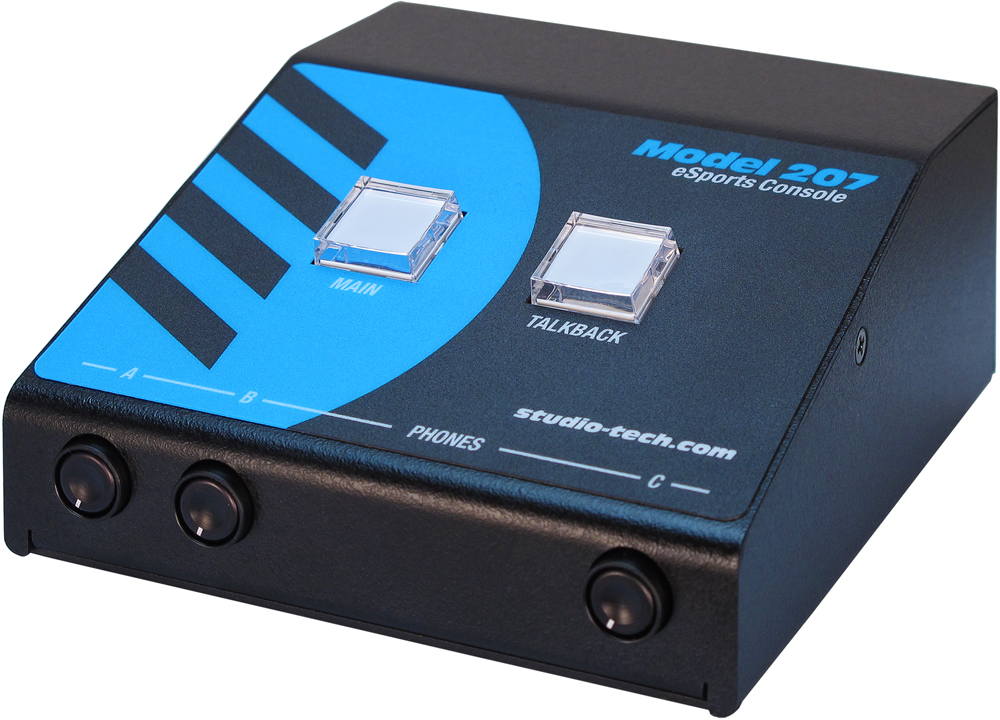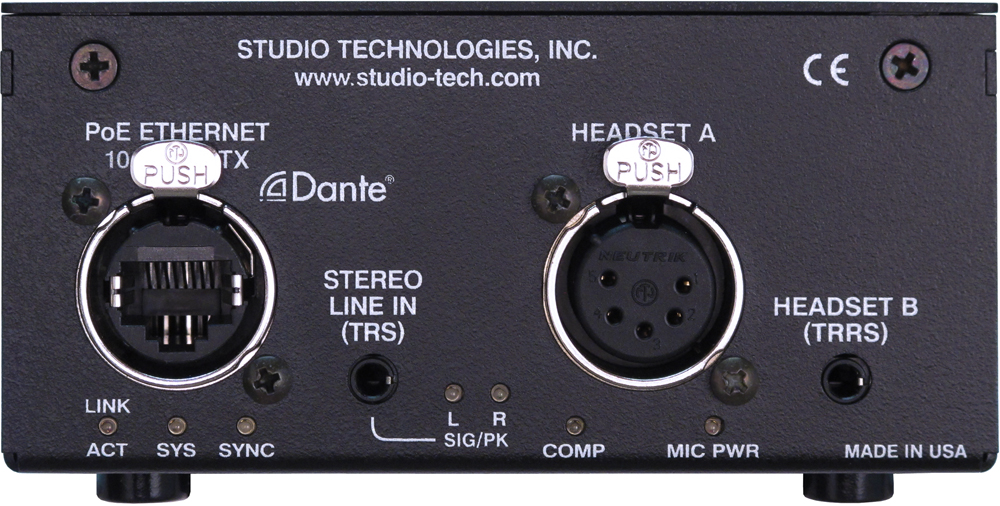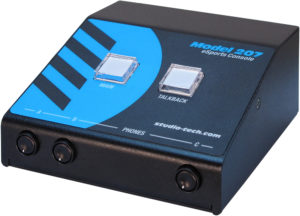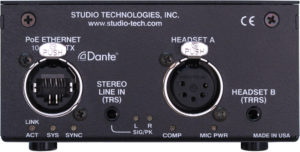The Model 207 eSports Console offers a unique combination of analog and digital audio resources specifically intended to support eSports-related live event, entertainment, and streaming broadcast applications. The unit is housed in a compact, rugged steel enclosure that's intended for table-top use. Its diminutive size also makes it ideal for use in space-constrained locations. Blue LED lights cast a distinctive "underglow" from the bottom of the enclosure. The Model 207 supports Dante® audio-over-Ethernet digital media technology with AES67 compatibility for integration into contemporary applications. The unit is extremely simple to deploy, is "pro" quality throughout, and provides an intuitive user experience. The Model 207's audio quality is excellent, with low distortion, low noise, and ample headroom. Careful circuit design and rugged components ensure long, reliable operation.
The Model 207 integrates directly into both Dante audio-over-Ethernet and standard analog audio environments. With just a Power-over-Ethernet (PoE) connection, a broadcast or "gaming" headset, and a connection to a stereo line-level audio source, a complete player position can be created.
Model 207 operating features are configured using the STcontroller software application. An extensive set of parameters allows the unit's functions to be tailored to meet the needs of many applications. STcontroller is a fast and simple means of confirming and revising the unit's operating parameters.
Applications
The Model 207 on its own can provide an "all-Dante" solution for one game player location. The unit's small size makes it ideal for live applications where physical space for personnel is very limited. Four Dante receiver (input) channels supply the user with their talent cue (IFB) signals. Should the cue signal be "mix-minus" an integrated sidetone function can provide the user with a microphone confidence signal. Two Dante audio output channels are associated with a connected headset's microphone, one designated as main and the other as talkback. Two additional Dante outputs have signal sources derived from the Model 207's stereo line input. These two audio channels, typically provided by a personal computer, can also be routed to the headphone output. The four Dante transmitter (output) channels are routed via an associated local area network (LAN) to inputs on Dante-compatible devices. Two pushbutton switches, main and talkback, provide the user with direct control over audio routing. The audio switching is performed in the digital domain and is virtually "click-free." Three rotary controls allow the user to create their own headphone audio mix.
Setup and Operation
Set up, configuration, and operation of the Model 207 is simple. An etherCON® RJ45 jack is used to interconnect with a standard twisted-pair Ethernet port associated with a PoE-enabled network switch. This connection provides both power and bidirectional digital audio.
A dual-channel (dual-ear or "stereo") broadcast headset can be directly connected to the unit's 5-pin female XLR connector. In addition, a 3.5 mm 4-conductor TRRS jack allows direct connection of gaming-style headsets. For each headset type, the microphone input is compatible with dynamic or electret microphones. The integrated low-voltage DC source provides power support for electret microphones.
A 3.5 mm 3-conductor TRS jack supports connection of a computer's analog line-level audio output. The Model 207 takes this computer audio source and makes it part of the Dante audio network by first converting it to digital and then outputting it by way of two Dante transmitter (output) channels. The audio from the stereo line input can also be configured to be part of the sidetone confirmation signal that is sent to the headphone output.
The STcontroller software application is used to configure the wide range of Model 207 operating parameters. This allows the unit's performance to be optimized to meet the needs of specific applications.
The user is presented with two pushbutton switches and three push-in/push-out rotary level potentiometers. This makes it easy to control the status of the main and talkback outputs as well as adjusting the signals that are sent to the headphone output channels.
Ethernet Data and PoE
The Model 207 connects to a local area network (LAN) by way of a standard 100 Mb/s twisted-pair Ethernet interface. The physical 100BASE-TX interconnection is made by way of a Neutrik® etherCON RJ45 connector. While compatible with standard RJ45 plugs, etherCON allows a ruggedized and locking interconnection for harsh or high-reliability environments.
The Model 207's operating power is provided by way of the Ethernet interface using the 802.3af Power-over-Ethernet (PoE) standard. This allows fast and efficient interconnection with the associated data network. To support PoE power management, the Model 207's PoE interface enumerates (reports) to the power sourcing equipment (PSE) that it's a class 2 (low power) device. If a PoE-enabled Ethernet port can't be provided by the associated Ethernet switch a low-cost PoE midspan power injector can be utilized.
Dante Audio-over-Ethernet
Audio data is sent to and received from the Model 207 using the Dante audio-over-Ethernet media networking technology. As a Dante-compliant device, the Model 207's two Dante transmitter (output) channels and four Dante receiver (input) channels can be assigned (routed or "subscribed") to other devices using the Dante Controller software application. The Dante transmitter (output) and receiver (input) channels are limited to supporting four Dante flows, two in each direction. The digital audio's bit depth is up to 24 with a sampling rate of 44.1 or 48 kHz. Two bi-color LEDs provide an indication of the Dante connection status. An additional LED displays the status of the associated Ethernet connection.
The Model 207 is compatible with the AES67 interoperability standard. In addition, the unit is compatible with the Dante Domain Manager™ (DDM) software application.
Audio Quality
The Model 207's audio performance is completely "pro." A low-noise, wide dynamic-range microphone preamplifier and associated voltage-controlled-amplifier (VCA) dynamics controller (compressor) ensures the headset's microphone audio quality is preserved while minimizing the chance of signal overload. The output of the microphone preamp and compressor is routed to an analog-to-digital conversion (ADC) section that supports sampling rates of 44.1 and 48 kHz with a bit depth of up to 24. The audio signal, now in the digital domain, routes through a 32-bit microprocessor and on to the Dante interface section where it is packetized and prepared for transport over Ethernet.
Audio signals arrive via the four Dante receiver (input) channels and pass into the Model 207's microprocessor. The supported sampling rates are 44.1 and 48 kHz with a bit depth of up to 24. Channel routing, headphone level control, and sidetone creation are performed within the digital domain. This provides flexibility, allowing precise control and keeping the three level potentiometers from having to directly handle analog audio signals. The audio channels destined for the phones outputs are sent to a high-performance digital-to-analog converter and then on to robust driver circuitry. High signal levels can be provided to the connected headset or earbuds with microphone.
Configuration Flexibility
The Model 207 can be configured to meet the needs of specific applications and user preferences. All configuration choices are performed using the STcontroller software application. Selectable parameters include microphone preamplifier gain, microphone power source on/off, button operation, headphone source routing and control operation, sidetone operation, and overall unit operation. In addition, the intensity of the LED indicators can be configured as desired. The gain of the microphone preamplifier can be selected from among five choices. This allows the Model 207 to match the output sensitivity of a range of headset-associated microphones. A source of low-voltage DC power can be enabled if required to support electret microphones.
The main and talkback pushbutton switches can be individually configured. The main button can be selected to operate from among six modes while the talkback button can be selected from among four. These choices allow the Model 207's operation to be tailored to meet the specific needs of many applications. As an example, for an on-air application the main button might need to be configured to provide a push to mute (cough) function. The microphone signal routed to the Dante main output channel would remain active unless a game player needs to momentarily disable it. The talkback button would most likely be set to the push to talk mode as its use would be intermittent.
The audio sources and the way in which they are assigned to the headphone output channels and front-panel rotary controls can be configured from among many choices. Each choice is unique, allowing almost any required headphone monitoring situation to be implemented.
There's even the ability to route two Dante receiver (input) channels directly to the headphone output channels. In this configuration the level of the audio signals sent to the headphone output will not be impacted by the rotary controls. This capability is included specifically to support gaming applications where a "masking" audio signal needs to be sent to each player's headset.
The integrated sidetone function allows audio associated with the microphone input to be sent to the headphone output. This is important as different applications may provide either a "full mix" or a "mix-minus" talent cue signal. If a full mix cue signal is provided then sidetone audio will not be needed and the function can be disabled. In the case where a mix-minus signal is present, providing the user with sidetone can be an important means of confirming the signal that's coming from the connected microphone.
Three system modes select the overall way in which the Model 207 functions. The on-air mode is optimized for applications where strict separation between on-air and production audio channels is required. Other applications will benefit from the two available production modes.
Future Capabilities and Firmware Updating
The Model 207 was designed so that its capabilities and performance can be enhanced in the future. A USB connector, located on the unit's main circuit board (underneath the unit's cover), allows the application firmware (embedded software) to be updated using a USB flash drive.
The Model 207 uses the Audinate Ultimo™ integrated circuit to implement the Dante interface. The firmware in this integrated circuit can be updated via the Ethernet connection, helping to ensure that its capabilities remain up to date.





